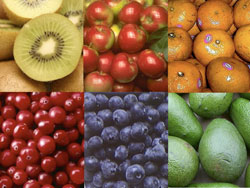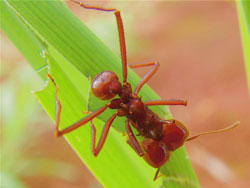 Some of the many fruits for which honey bees are an important pollinator: kiwi fruit, apples, citrus, cranberries, blueberries, avocado
Some of the many fruits for which honey bees are an important pollinator: kiwi fruit, apples, citrus, cranberries, blueberries, avocado
Honey bees, Apis mellifera, and social insects are important in both applied and basic science. On the applied side, honey bees are of great importance in agriculture. Their annual value in agricultural pollination is estimated at £200 million in the UK and $15 billion in the USA. Worldwide, honey bees also provide an annual honey crop of approximately one billion kilograms. As a result, there is a great deal of interest in studying honey bee diseases and bee keeping in general. But the honey bee is also of great importance in basic science. It was the first species in which colour vision was understood both in terms of the visual receptors in the eye and the abilities of whole animals to learn and react to colours. The honey bee also has an extremely complex communication system, including the famous 'waggle dance', by which forager bees can direct nestmates to the flower patches where they have been foraging. Honey bees are also key organisms in studying many other areas of biology including collective decision making, organization, conflict resolution, developmental biology and many other topics. Honey bees are also extremely important in natural ecosystems, being the most important of all pollinators.
 Social insects can also be pests. Atta leafcutter ants, which are found in tropical and subtropical America, may cut the leaves of crop plants
Social insects can also be pests. Atta leafcutter ants, which are found in tropical and subtropical America, may cut the leaves of crop plants
The same applies to other social insects. Many social insects have great economic significance, often as pests. Termites can destroy wooden buildings, and imported ants can become major pests outdoors, such as the fire ant Solenopsis invicta, or indoors, such as the Pharaoh’s ant Monomorium pharaonis. Leafcutter ants can be pests in agriculture. When they are pests, social insects can be extremely hard to control. All types of social insect are important in basic science. Many species of ants have been studied to investigate how insect colonies organise themselves, and the ideas from this research have even inspired computer scientists. Many ants also have complex symbiotic relationships with other species, such as the leafcutter ants that have underground fungus gardens producing most of the food the colony needs from a compost of fresh leaves. Social wasps do not have many friends among the general public, but their societies have been of great use to biologists in understanding how social behaviour evolved and for studying conflict resolution. Just like honey bees and other social bees with their role as pollinators, termites, ants, and social wasps are of great importance in natural ecosystems. In tropical forests their biomass may exceed that of all vertebrate animals combined. Ants are major predators of other insects, but some species, like the leafcutter ants, are important herbivores. Ants nesting underground play an important role by tunnelling into the soil, which allows rainwater to penetrate. Wasps are major predators of other insects. Termites mainly eat dead plant material, and in this way play a vital role in recycling nutrients.


